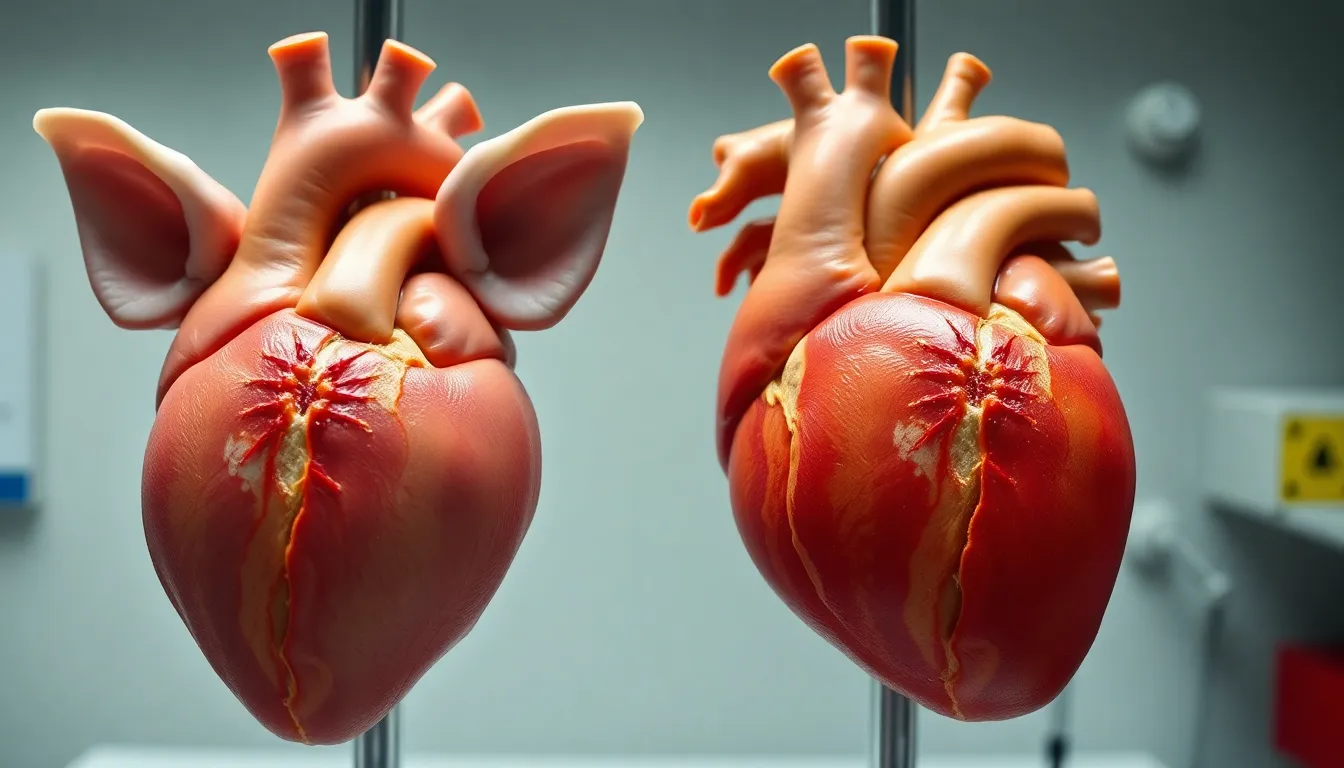The comparison between pig hearts and human hearts has gained significant attention in recent years, particularly in the fields of medicine and transplantation. As researchers explore innovative solutions to the global organ shortage, the similarities and differences between these two organs could hold the key to groundbreaking advancements in heart transplants.
Pigs share a surprising number of anatomical and physiological traits with humans, making them prime candidates for xenotransplantation. Understanding how pig hearts function compared to human hearts not only sheds light on potential medical applications but also raises ethical questions that society must address. Delving into this fascinating topic reveals the complexities of organ compatibility and the future of heart health.
Table of Contents
ToggleOverview of Pig Heart Vs Human Heart
Pig hearts and human hearts exhibit significant anatomical and physiological similarities. Both possess four chambers: two atria and two ventricles. This similarity aids in understanding heart function and emergencies, making pigs a viable alternative for research purposes.
The size of a pig heart closely matches that of a human heart. Adult pigs typically weigh between 250 and 300 pounds, resulting in hearts that range from 300 to 400 grams. In comparison, an average human heart weighs between 250 to 350 grams. This resemblance allows for easier adaptation in surgical scenarios.
Blood flow dynamics are also comparable. Both hearts pump blood through similar circulatory systems, encompassing systemic and pulmonary circuits. Oxygenation of blood occurs in the lungs, and both heart types support similar blood pressure ranges. These functional parallels make studying pig hearts advantageous in exploring cardiac treatments and surgical techniques.
Ethical considerations arise in the context of xenotransplantation. Utilizing pig hearts for transplants could alleviate organ shortages, yet concerns about immune rejection and disease transmission persist. Ensuring compatibility through genetic modifications remains a focus for researchers aiming to enhance transplant success.
While the anatomical and physiological aspects of pig hearts are closely aligned with human hearts, the integration of these organs into clinical practice requires careful ethical and medical scrutiny.
Anatomical Differences

Pig hearts and human hearts exhibit notable anatomical differences while sharing several similarities. Understanding these differences aids in assessing their potential for organ transplantation and medical research.
Size and Structure
Pig hearts typically weigh between 300 to 400 grams, while human hearts average 250 to 350 grams. Both hearts contain four chambers: two atria and two ventricles. The overall dimensions of pig hearts, including length and width, are slightly larger than those of human hearts. Despite this size discrepancy, the structural design of valves and chambers remains fundamentally similar. This structural compatibility offers potential advantages in transplantation scenarios.
Valves and Chambers
Pig hearts possess valves similar in type and function to human hearts. Both contain atrioventricular and semilunar valves that ensure unidirectional blood flow. The atrioventricular valves, namely the tricuspid and mitral valves, function comparably in pigs and humans. Moreover, the semilunar valves, consisting of the pulmonary and aortic valves, operate with similar mechanics. These anatomical similarities in valves and chambers support the exploration of pig hearts as viable alternatives for human organ transplants.
Functional Comparisons
The functional aspects of pig hearts and human hearts reveal substantial similarities that have implications for medical applications, particularly in transplantation.
Blood Circulation
Blood circulation in both pig and human hearts operates through similar pathways, ensuring efficient oxygen and nutrient distribution throughout the body. In pigs, the heart pumps blood with a similar flow pattern as that of humans, involving the right atrium, right ventricle, lungs, left atrium, and left ventricle. The systolic and diastolic phases are comparable, allowing for effective pressure generation within each chamber. Studies indicate that the systemic and pulmonary circulatory dynamics exhibit minimal differences, supporting their use in research aimed at understanding cardiac health and disease.
Cardiac Output
Cardiac output, a critical measure of heart function, demonstrates comparable values in both pig and human hearts. The average cardiac output for humans ranges from 4.7 to 5.6 liters per minute, while pigs typically show values around 5 to 6 liters per minute, depending on size and activity level. This similarity in output indicates that pig hearts can sustain similar metabolic demands as human hearts. Understanding these metrics aids researchers in designing and testing potential treatments for heart diseases, utilizing pig hearts as models to predict human outcomes effectively.
Implications for Transplantation
The comparison of pig hearts and human hearts carries significant implications for transplantation, impacting both ethical considerations and medical advancements. Researchers and ethicists explore this evolving field to address critical issues surrounding organ transplantation.
Ethical Considerations
Ethical concerns regarding pig heart transplantation must be addressed due to potential risks of disease transmission, organ compatibility, and immune rejection. Pigs may harbor zoonotic diseases that could transfer to humans, prompting extensive screening and genetic modifications to minimize this risk. Public perception of animal-to-human organ transplantation also plays a role; society’s acceptance hinges on ethical sourcing and treatment of donor animals. Regulatory frameworks are essential to ensure humane practices in organ harvesting and transplantation procedures, fostering trust and transparency in clinical applications.
Medical Advancements
Medical advancements in xenotransplantation technology continue to evolve as researchers seek to enhance the viability of pig hearts for human use. Genomic editing techniques, such as CRISPR, facilitate the modification of pig genes to reduce immune response and improve organ compatibility. Clinical trials are ongoing to assess the long-term outcomes of pig heart transplants, focusing on functional similarities that promise improved patient health. Innovations in immunosuppressive therapies may further reduce rejection rates, making pig hearts a potential solution to the organ shortage crisis. As developments progress, the collaboration between geneticists, surgeons, and ethicists will play a crucial role in the successful integration of pig hearts into transplantation practices.
The exploration of pig hearts as alternatives to human hearts presents both exciting possibilities and significant challenges. With their anatomical and functional similarities, pig hearts could play a vital role in addressing the pressing organ shortage. However, the ethical implications and potential health risks associated with xenotransplantation warrant careful consideration.
As researchers continue to innovate and refine techniques for organ compatibility and disease prevention, the future of pig heart transplantation remains hopeful. Ongoing studies and clinical trials will be crucial in determining the feasibility and safety of these procedures. The collaboration among various experts will ultimately shape the path forward, ensuring that any advancements are both ethical and beneficial to patients in need.




